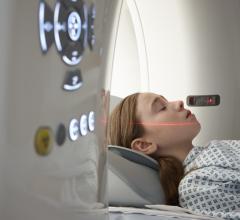April 3, 2008 - In preparation for the Beijing 2008 Olympic Games, the U.S. Olympic Committee (USOC) and the General Electric Company said this week two research programs have started to demonstrate health monitoring using ultrasound imaging and early intervention leads to injury prevention and enhanced health and sports performances for athletes.
The first program is a cardiac clinical research study with top U.S. Olympic athletes and hopefuls on the U.S. Men’s Rowing and USA Weightlifting teams while the second initiative will monitor the musculoskeletal health of athletes competing for USA Weightlifting, USA Boxing, USA Wrestling and the U.S. Soccer Women’s National Team. These two studies are continuations from research programs at the Torino 2006 Olympic Winter Games.
“Every day an Olympic athlete spends in rehab is a day lost in training, making earlier injury diagnosis and real-time recovery monitoring crucial for elite performance," said Dr. Michael Reed, U.S. Olympic Committee medical director, performance services division. "It is increasingly important that as a National Olympic Committee, we have the most innovative tools to help predict, diagnose, treat and monitor sports injuries earlier to ensure a quick return to play. It’s my belief that GE’s ultrasound technology will become a standard tool in healthcare for athletes."
A clinical study of USA Weightlifting and U.S. Men’s Rowing, led by Dr. Malissa Wood, of the Massachusetts General Hospital Heart Center (MGH) in Boston, will use GE’s Vivid i – an advanced, miniaturized cardiovascular ultrasound system – to examine athletes’ hearts pre- and post-competition to learn more about the function and performance of highly-conditioned hearts. The study is ongoing for Dr. Wood, who also partnered with the USOC and GE Healthcare by studying the hearts of U.S. Short Track Speedskaters for the Olympic Winter Games in Torino. The results from the study so far indicate there are specific changes in heart function that correlate to different levels of training.
According to Dr. Wood and Dr. Michael Picard from MGH, results of their Torino study proved participation by world-class speedskaters in a vigorous training regimen results in cardiovascular anatomic and physiologic adaptations. These changes, including cardiac chamber dilatation, enhanced ventricular diastolic function and attenuated resting right ventricle systolic function, are likely adaptive and allow for more efficient energy use at rest and a robust response to demands of exercise. In other words, these athletes had an enlargement of the cavities of the heart and better function of the heart compared to others that are the same age and gender.
In an effort to further confirm results from Torino, the current research program leading to Beijing will study athletes from traditionally recognized high-intensity sports (rowing and weightlifting) and compare differences in heart function and energy use with endurance athletes as well as people from the general population.
"This study aims to evaluate elite athletes’ cardiac adaptation to high-intensity exercise and training by analyzing cardiac response during peak and off-peak training cycles," said Dr. Wood. "Our work will hopefully grant the sports medicine community with greater insight to the cardiac fitness levels of their athletes, and provide healthcare providers with insight to new, more effective ways of assessing and treating heart disease for the non-athlete."
GE’s Vivid i ultrasound system offers the functionality and high performance of larger-scale systems, but in a portable and wireless design. The system makes it possible for patients to receive full diagnostic exams anywhere, as opposed to being transported to an imaging lab in a hospital.
Research with USA Weightlifting, USA Boxing, USA Wrestling and the U.S. Soccer Women’s National Team will focus on point-of-injury diagnosis. The second clinical study, led by Drs. Marnix T. van Holsbeeck, Tony Bouffard and Scott A. Dulchavsky of Henry Ford Hospital in Detroit, MI, centers on improving the overall musculoskeletal health of athletes on the field.
Researchers will focus their attention on the hip, shoulder, ankle and knee regions and, similar to efforts in Torino with the U.S Women’s Hockey team, they will investigate whether taking healthy baseline scans of the athletes helps in determining the extent of future sports injuries with greater speed and accuracy. For the Beijing Olympic Games, the Henry Ford investigators want to assess whether changes in ligaments, cartilage and muscle that are seen before the Olympic Games may have an effect on the athletes performances during the games.
According to Dr. van Holsbeeck, ultrasound can highlight problems with structure and with mobility of tissues that no other examination technique can show. In this study, researchers will use GE’s LOGIQ i, a lightweight, portable ultrasound system that enables real-time diagnosis. Designed for a modern, all-digital healthcare environment, LOGIQ i allows clinicians to share information for consultation and to archive results electronically.
“In the Olympic Games, every second counts. Having a tool that can accurately and immediately determine the severity of an injury gives the sports physician the ability to determine if the athlete can continue to compete in time critical situations. It also can be used to guide training and rehabilitation after injuries,” said Dr. Dulchavsky. “This study empowers athletes and doctors to take a proactive approach with their health, potentially preventing injuries before they even occur.”
Both clinical studies are currently underway with initial results expected around the start of the Beijing Games. GE expects to conduct similar athlete research programs in other countries as well.
For more information: www.usolympicteam.com, www.usocpressbox.org, www.ge.com, www.gehealthcare.com


 July 25, 2024
July 25, 2024 








